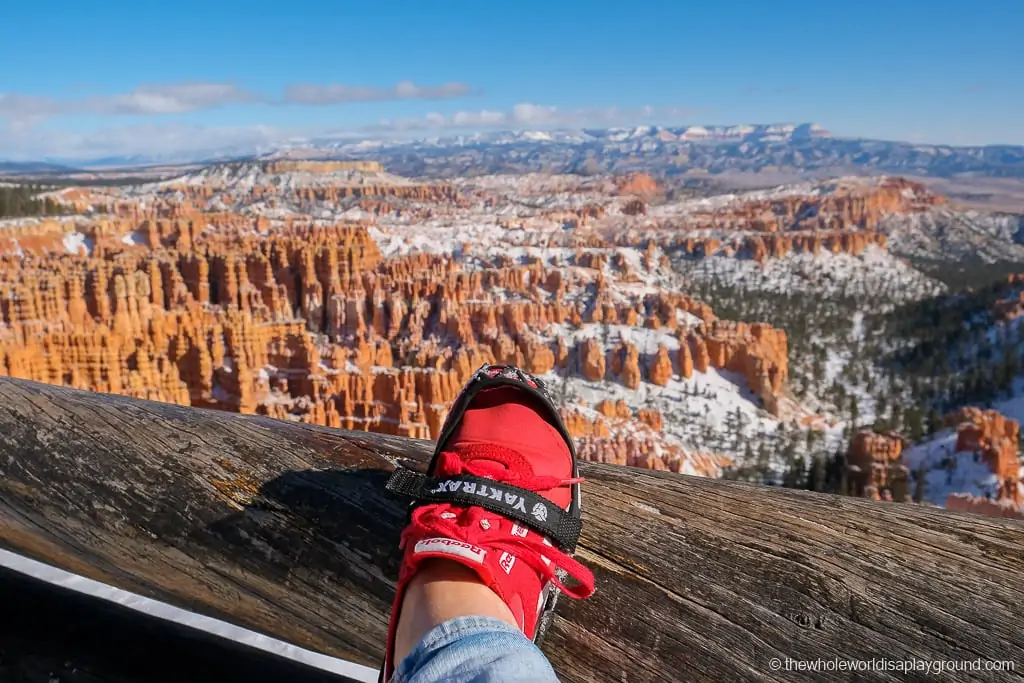Carved over millions of years by the Colorado River, the Grand Canyon is a truly magnificent place to visit and the size and scale of the canyon are impossible to put into words. For those of you planning a trip to the South Rim, we’ve put together our recommended Grand Canyon itinerary for 1, 2, and 3 day visits.
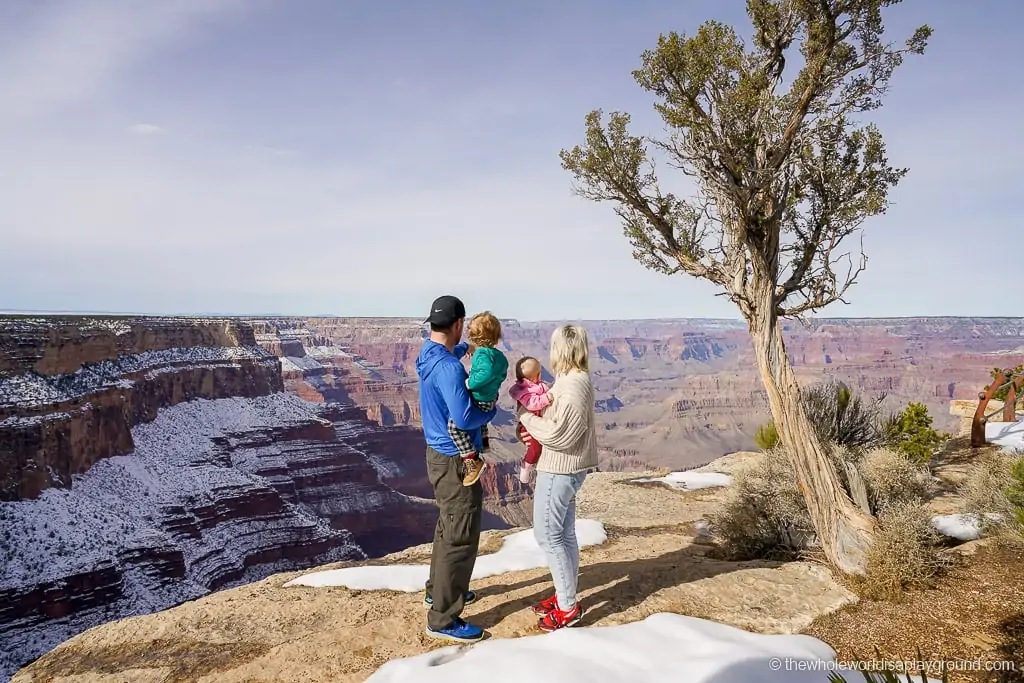
Grand Canyon South Rim Itinerary
We’ve included our 1, 2 and 3 day Grand Canyon South Rim itineraries. These itineraries assume full days at the South Rim – make sure to allow for travel days to and from the South Rim when you are planning your own Grand Canyon itinerary.
Grand Canyon 1 Day Itinerary
Our one Canyon 1 day itinerary showcases some of the South Rim highlights:
1 | Watch the sunrise over the canyon
Start the day with a magical sunrise at the Grand Canyon. We have a few favorite spots from where to watch the sunrise:
- Mohave Point on Hermit Road is one of our favorite sunrise viewpoints and the panoramic views are stunning.
- Mather Point is another great option and its location beside the Visitors Center means its easily accessible with adjacent parking.
- If you’re staying in the Grand Canyon Village then a walk along the Rim Trail offers magnificient sunrise views. The hike to the closest viewpoints, Trail View Point and Maricopa Point, offers stunning sunrise vistas.
Grand Canyon itinerary tip: The South Rim is open 24/7 so it is possible for anyone to visit for sunrise. It’s definitely easier if you are staying in Grand Canyon Village but it’s still doable from outside the park.
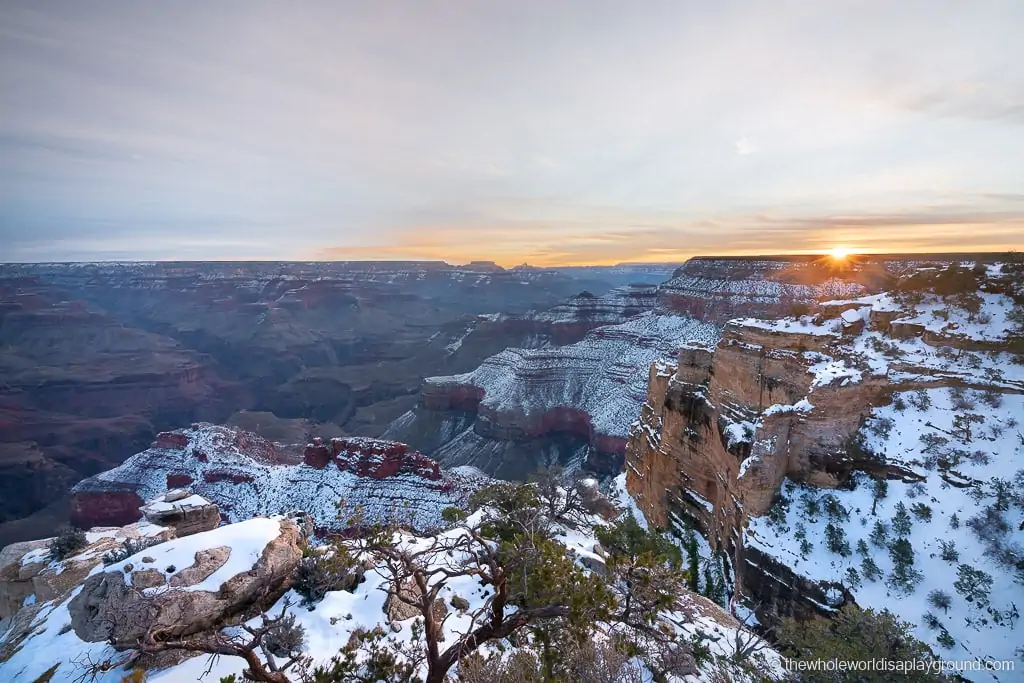
2 | Morning: Explore the Hermit Road Viewpoints
The Hermit Road viewpoints are a series of viewpoints located along Hermit Road to the west of the South Rim between Grand Canyon Village and Hermits Rest. The viewpoints offer incredible views of the Canyon. To explore the viewpoints you can hike, take the red shuttle (or drive in winter) or rent a bike from Bright Angel Bicycles and cycle along the rim.
Grand Canyon itinerary tip: Between March and November, the Hermit Road viewpoints are accessible only by the red shuttle bus or by hiking/biking the Rim Trail from Bring Angel Lodge. The shuttle loop takes around 80 to 90 minutes without allowing time for stops. During the winter months (December, January, and February) private vehicles are typically permitted and limited parking is available at the viewpoints.
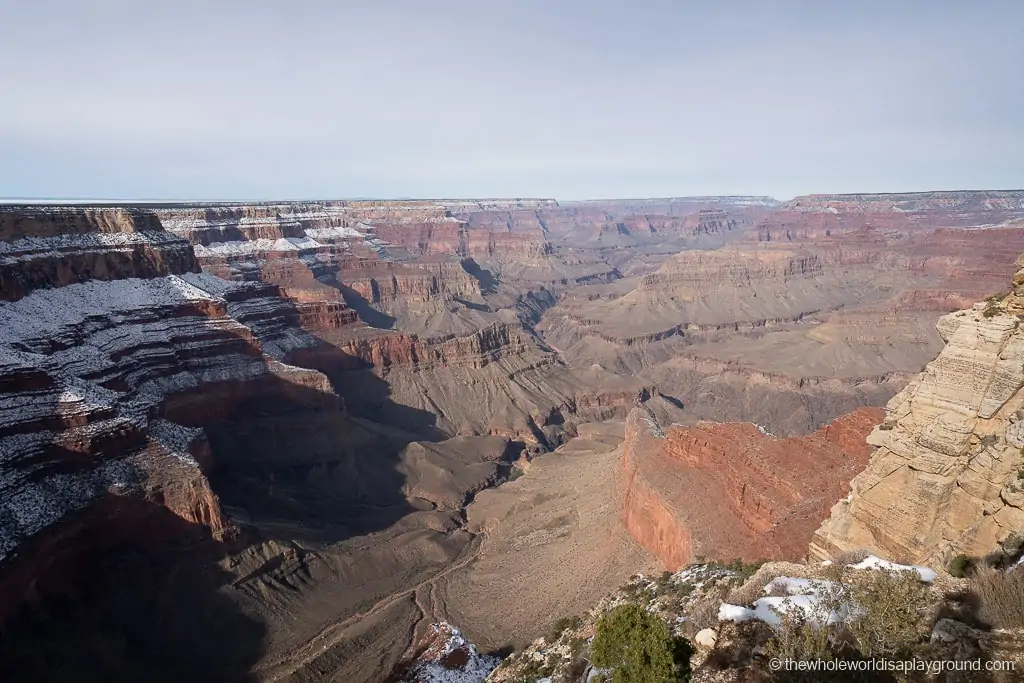
Viewpoints (and shuttle stops): Trailview Overlook – Maricopa Point – Powell Point – Hopi Point – Mohave Point – The Abyss – Monument Creek Vista – Pima Point – Hermits Rest
It takes around 2.5 hours to walk the 7 miles between the Grand Canyon Village and Hermits Rest but you can take the shuttle bus between stops. A great option is to hike out to Trail View Overlook or to Maricopa Point and use the shuttle from there.
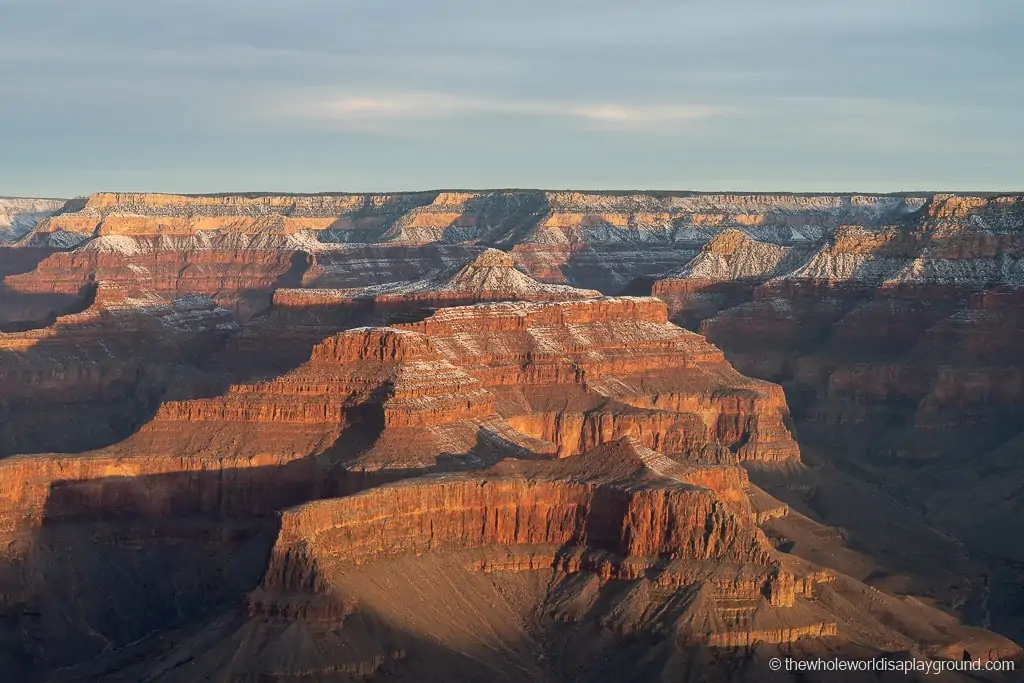
If you opt to rent bikes then the Hermit Road Greenway is our favorite spot for a bike ride: the 2.8mile trail between Monument Creek Vista and Hermit Rest is packed with viewpoints and it is separate from the road so there are no vehicles to contend with.
3 | Lunch: Stop for food at Hermit’s Rest or in the Village
There are lots of places to eat in the Grand Canyon Village or you can even bring a picnic.
There’s a snack bar at Hermit’s Rest, a couple of food trucks in the village, and a casual cafe at Bright Angel Lodge. If you want to eat somewhere special then the historic El Tovar is a real treat with its fine dining and canyon views.
Our favorite picnic spot along the rim is Hermit’s Rest, where you can enjoy beautiful views and fewer crowds.
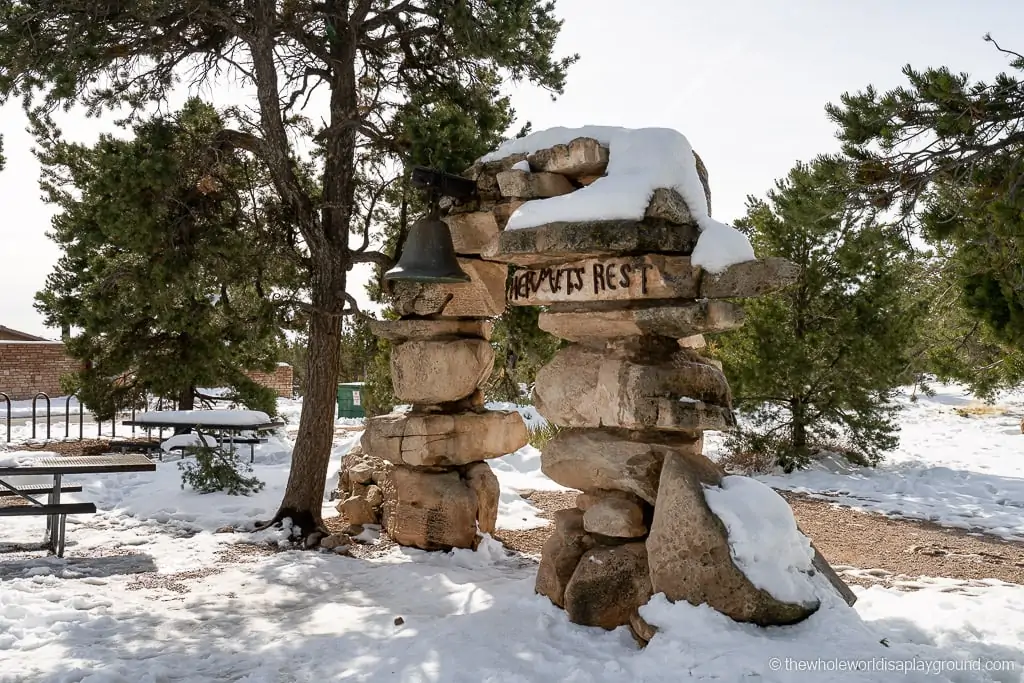
4 | Afternoon: Check out the Viewpoints East of Grand Canyon Village
There are some awesome viewpoints located to the east of the Grand Canyon Village. Mather Point is adjacent to the Vistors Center and has stunning views and Yavapi Point is also magnificent. The views from Yaki Point are quite different from other viewpoints at the South Rim with open views of the Canyon to the east.
Grand Canyon itinerary tip: If you are out along the Rim Trail you can take the red Hermit Road Shuttle over to the Village and then the blue village shuttle over to the Visitor’s Center. The orange Kaibab Rim shuttle bus stops at the Visitors Center and services the viewpoints. There is parking at the Visitors Center if you want to drive over and Desert Drive also has limited parking.
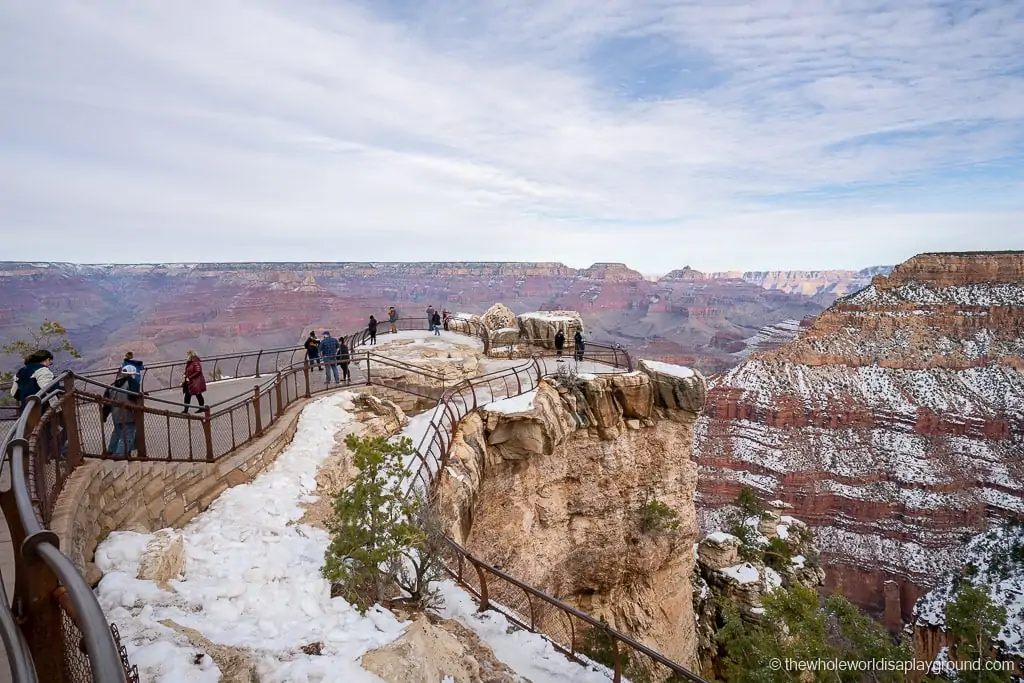
5 | Step Back in time at the Yavapi Museum and Walk the Trail of Time
If you want to learn more about the Grand Canyon then stop by the Yavapi Geology Museum. The museum is located on the edge of the canyon and has wonderful panoramic views. It also has some fantastic exhibitions explaining how the Grand Canyon was formed.
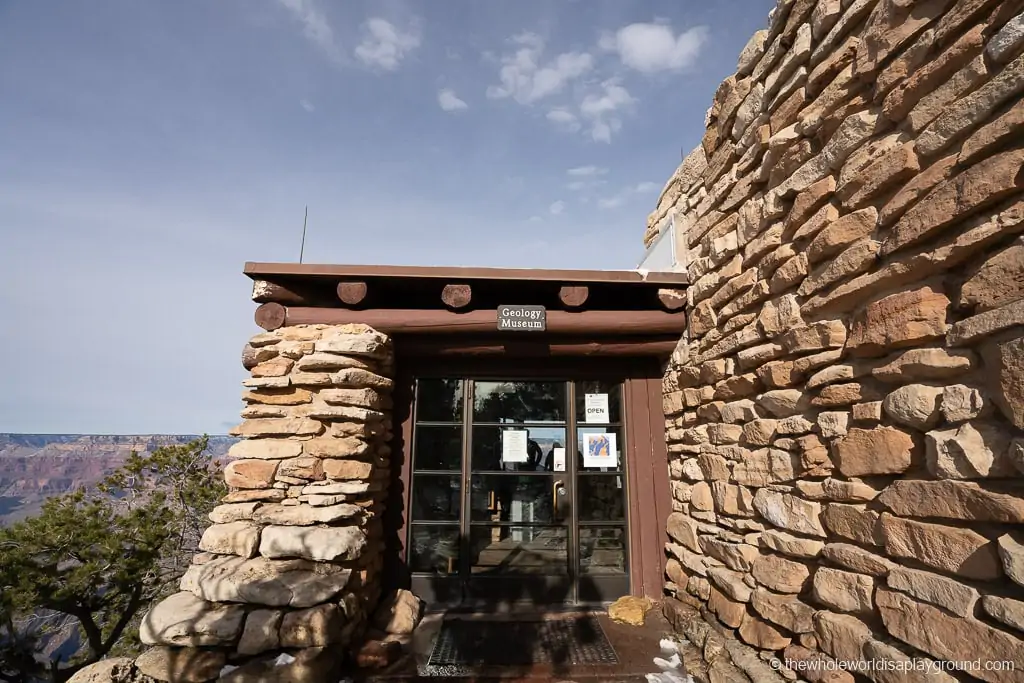
One of the highlights of the museum is the large relief map that shows all of the features of the Grand Canyon on a small scale.
The Trail of Time, where each meter walked represents 1 million years of history, is an almost 3 mile flat paved walk that begins at the Yavapi Geology Museum. It’s a fantastic visual representation of the formation of the Grand Canyon.
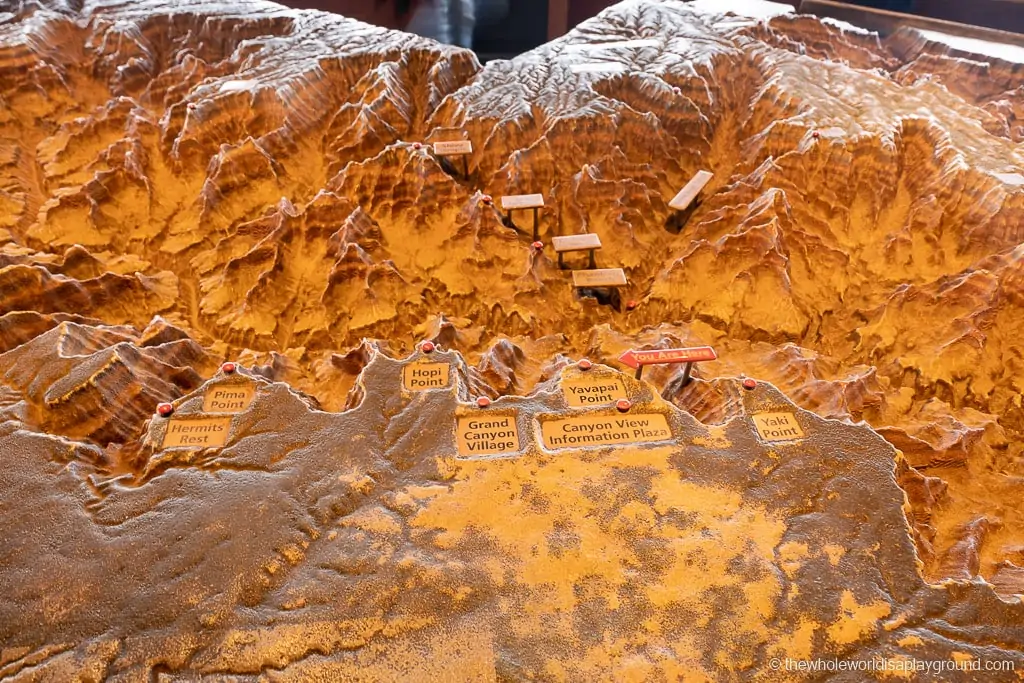
5 | Evening: Watch the sunset over the canyon
Yaki Point is a great option for sunset as it’s usually quiet and you can find a quiet area to enjoy an epic Grand Canyon sunset. The colors are wonderful and the Desert View Watchtower is visible in the distance.
Grand Canyon itinerary tip: Yaki Point is one of the lesser visited viewpoints at the South Rim as there is no car access to the viewpoint. Visitors can only get to Yaki Point by parking on Desert View Drive and walking or by taking the free shuttle bus that runs east bound from the Grand Canyon Visitors Center.
Hopi Point, with its wide unobstructed views, is another sunset favorite as is the ever-popular Mather Point adjacent to the Visitors Center.
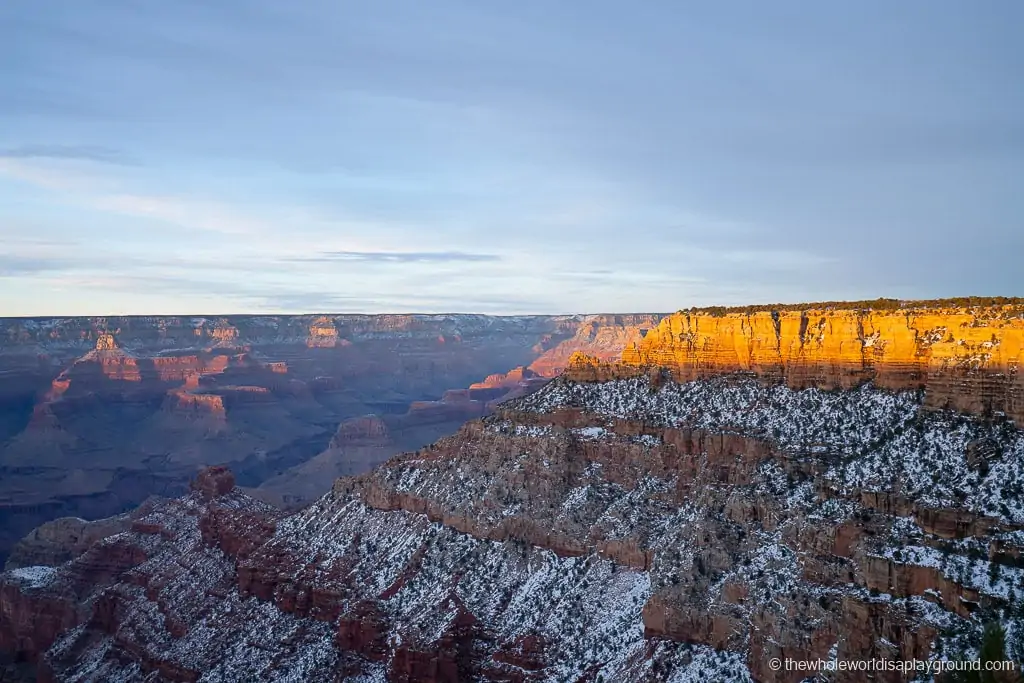
For a unique sunset experience, the Pink Jeep Tour is one of the most popular tours at the Grand Canyon. You can ride in an open-top while checking out some magical South Rim sunset spots – check prices now!
6 | Stargazing
If you are spending the night in one of the Grand Canyon lodges then make sure to pop outside and check out the night skies. The park is listed as an International Dark Sky Park and there are some great opportunities for stargazing. The stars are amazing from along the rim (obviously take extreme care in the dark). The viewpoints towards Desert View, which are away from much of the light pollution, are another awesome spot.
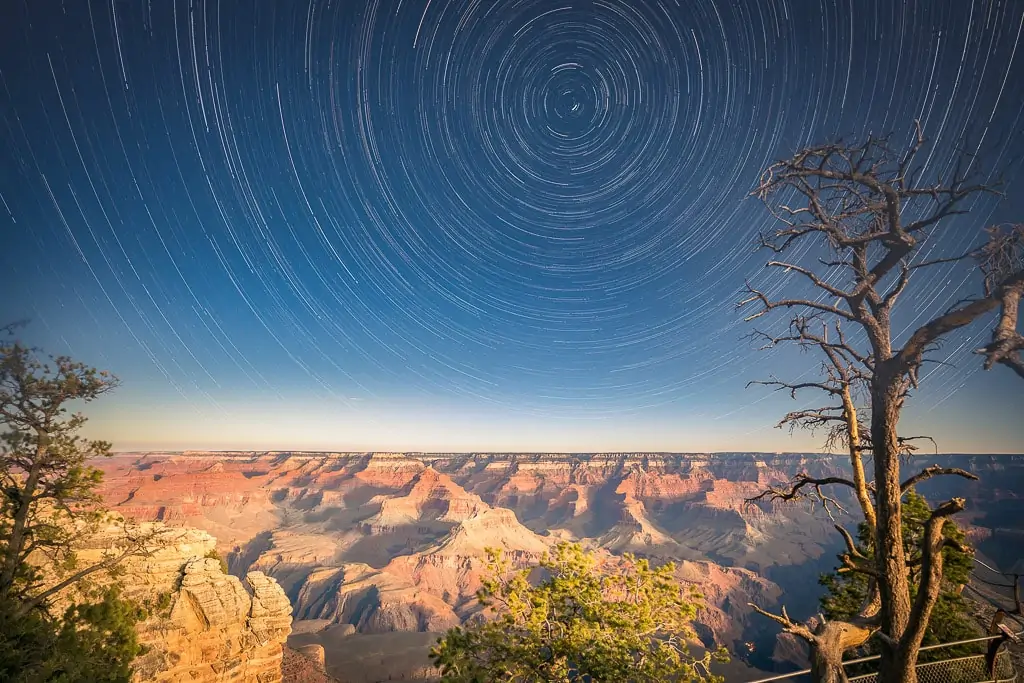
Where to stay in the Grand Canyon
There are two options for where to stay at the Grand Canyon South Rim:
- Within the park: stay in the historic El Tovar Hotel or one of the five lodges in Grand Canyon Village. You can also camp in one of the park’s 3 campgrounds.
- Outside the park: stay in one of the motels or rentals in the nearby town of Tusayan
In the park
Spending the night at the Grand Canyon is a wonderful experience. We’ve stayed in the park on our last couple of visits and love being able to catch the sunrise and sunset and have easy access to the shuttle buses.
Grand Canyon Itinerary tip: Park accommodation is limited so, if you are set on staying at the South Rim, make sure to reserve in advance.
The in-park accommodation is located in Grand Canyon Village, the center hub of the South Rim. The village is also well serviced by the park’s shuttle service.
- Bright Angel Lodge: we stayed at Bright Angel during our most recent trip. The lodge offers rooms and cabins and is located on the rim at the top of the Bright Angel trailhead. Bright Angel is often one of the cheapest options within the park – check prices now!
- Yavapi Lodge: a short walk from the South Rim, Yavapi Lodge can sometimes have later availability than the other lodges due to having 358 rooms. Some families prefer Yavapi as it’s located further back from the rim than the other lodges – check prices now!
- El Tovar Hotel: the South Rim’s premium accommodation option, the elegant El Tovar is a National Historic Landmark with 78 unique rooms and a fine dining restaurant – check prices now!
- Kachina Lodge: for those seeking regular style hotel rooms Kachina is a good option with clean and comfortable rooms. The lodge sits directly on the rim of the canyon and the views are incredible – check prices now!
- Thunderbird Lodge: situated between Bright Angel and Kachina Lodge, Thunderbird Lodge is also located directly on the canyon rim and many of the rooms offer partial views of the canyon – check prices now!
- Maswik Lodge: located in a wooded area near the rim of the Canyon, Maswik Lodge has 280 rooms across 12 buildings. The lodge has more of a contemporary style and rooms accessed via outside walkways. It’s a quick shuttle ride or quarter-mile walk from the lodge to the rim – check prices now!
Book your stay at the Grand Canyon now!
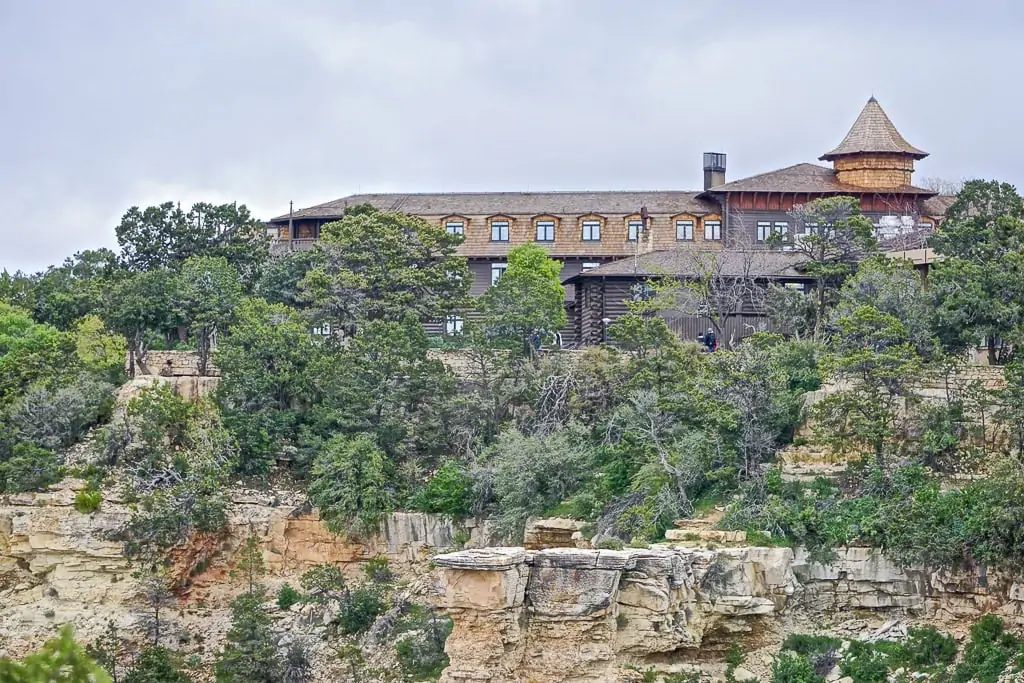
Outside the park: Where to Stay in Tusayan
- Best Western Premier Squire Inn: clean, modern and only a 10 minute drive from the Tusayan entrance to the park. This Best Western is our first choice for when we stay outside the park – check prices now!
- The Grand Hotel: one of the few hotels with an indoor heated pool to relax in after exploring. The hotel is only 1 mile from the South Entrance – check prices now!
- Vacation rentals: there are some great rental options in Tusayan and its surrounds. These apartments are a great option close to the south entrance and this tented camp offers a unique Grand Canyon experience – check prices now!
National Parks Pass America The Beautiful
If you’re planning to visit a couple of the US National Parks we highly recommend purchasing an America The Beautiful pass. The pass grants you access to over 2,000 federal recreation sites across the US, including all the National Parks. We purchased a pass before we began our trip across the US and it’s one of the best value tickets out there!
Buy your National Parks pass now!
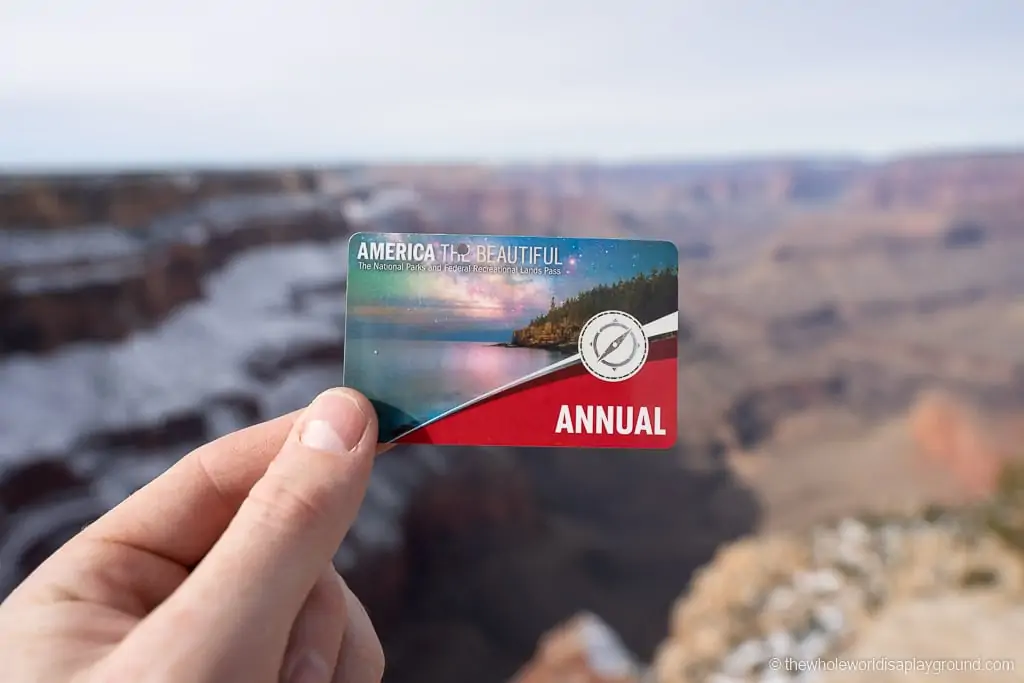
Grand Canyon 2 day itinerary
Spending a second day at the South Rim allows time to experience some unique Grand Canyon adventures. You can follow our Grand Canyon 1 day itinerary and then pick and choose from our other Grand Canyon favorites:
Grand Canyon itinerary tip: if you enjoyed the magical sunrise and sunset in our 1 day itinerary then make sure to check out some of our other recommended viewpoints for sunrise and sunset today.
1 | Short Hikes Below the Rim
Descending below the rim of the Grand Canyon allows you to experience the Grand Canyon from an entirely unique perspective.
The two most popular trails are the Bright Angel and South Kaibab trails and it is possible to hike a portion of either trail – remember, you need to save some energy for the climb back out of the canyon. It’s the hardest part and coming out of the canyon typically takes us twice as long as going down into it!
South Kaibab Trail: the South Kaibab Trail follows a ridgeline down into the Canyon and the views are spectacular but it’s a steeper hike up to the rim. There are lots of viewpoints along the South Kaibab Trail – our favorite short hike is the 1.8mile trail to Ooh Aah Point but you don’t have to go the full way. The trailhead for the South Kaibab trail is located on the shuttle bus route close to Yaki Point.
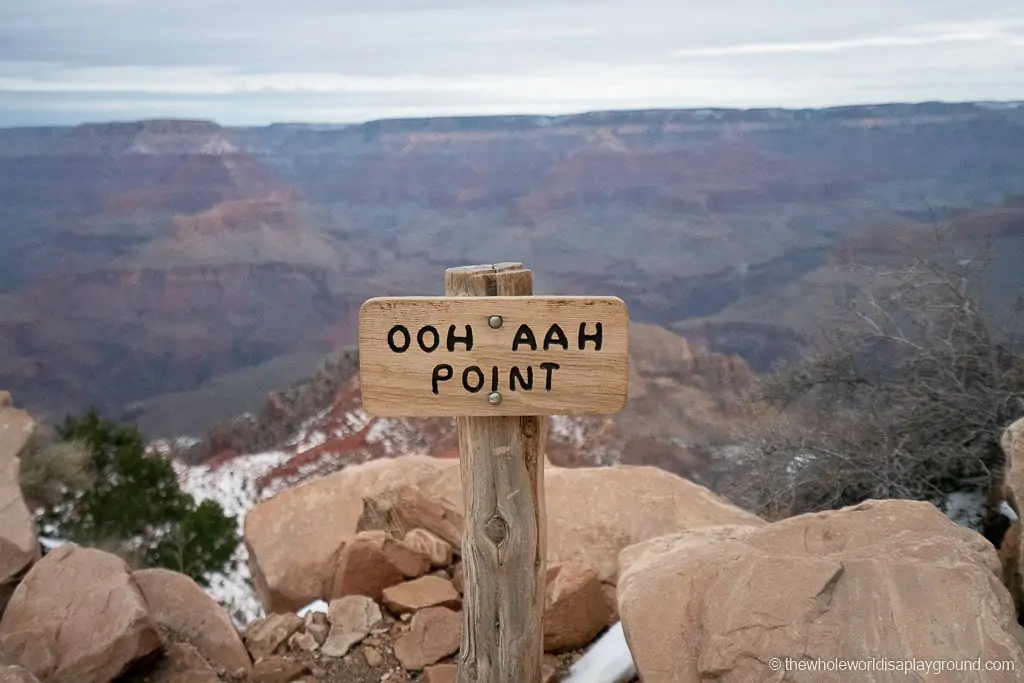
Bright Angel Trail: The Bright Angel trailhead is located at the rim beside Bright Angel Lodge and it follows a fault into the canyon via a series of steep switchbacks. There are shorter hiking options – the easiest is 1.5 Mile Resthouse.
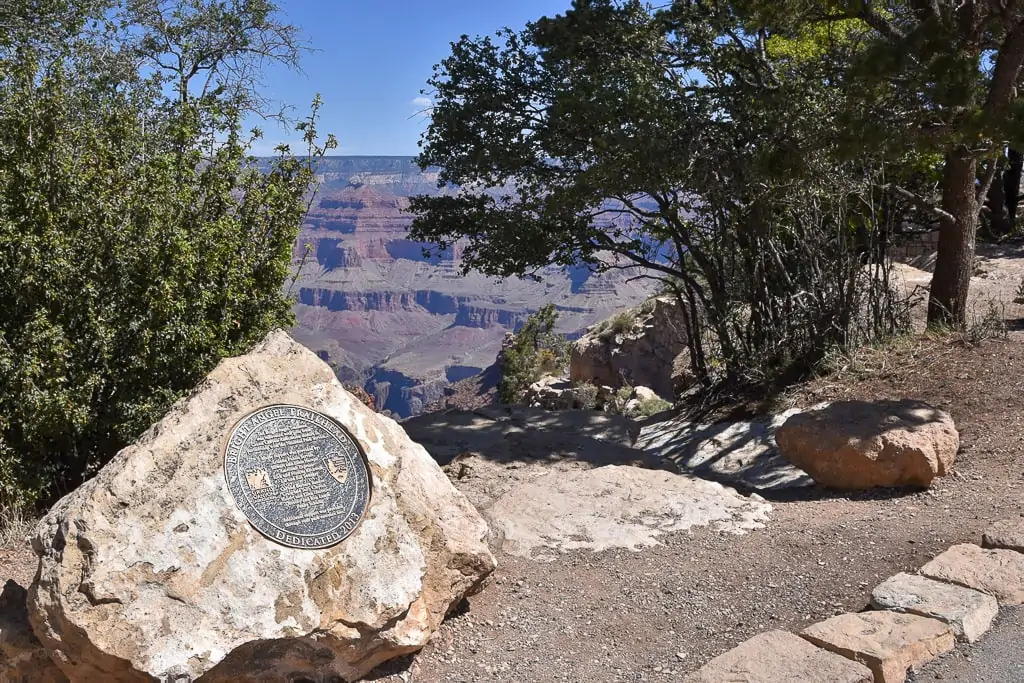
2 | Soar over the canyon in a helicopter
A helicopter flight is an amazing opportunity to soar above the Canyon and it showcases its indescribable size and scale. One of the best is the Spirit Helicopter Tour by Maverick Tours – it is a 45-minute scenic flight with amazing views of the Painted Desert, Kaibab National Forest, and Dragon Corridor, the widest and deepest part of the canyon. This is one of the best ways to experience the Grand Canyon and in our opinion is definitely worth the money. – check prices now!
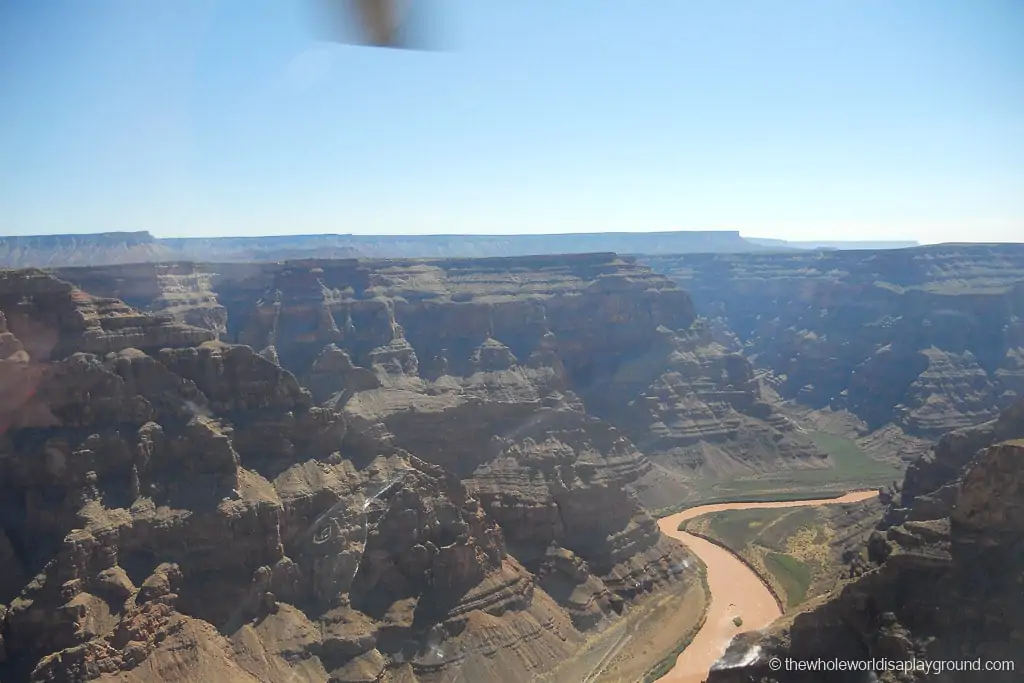
There are also fantastic airplane tours – check prices now!
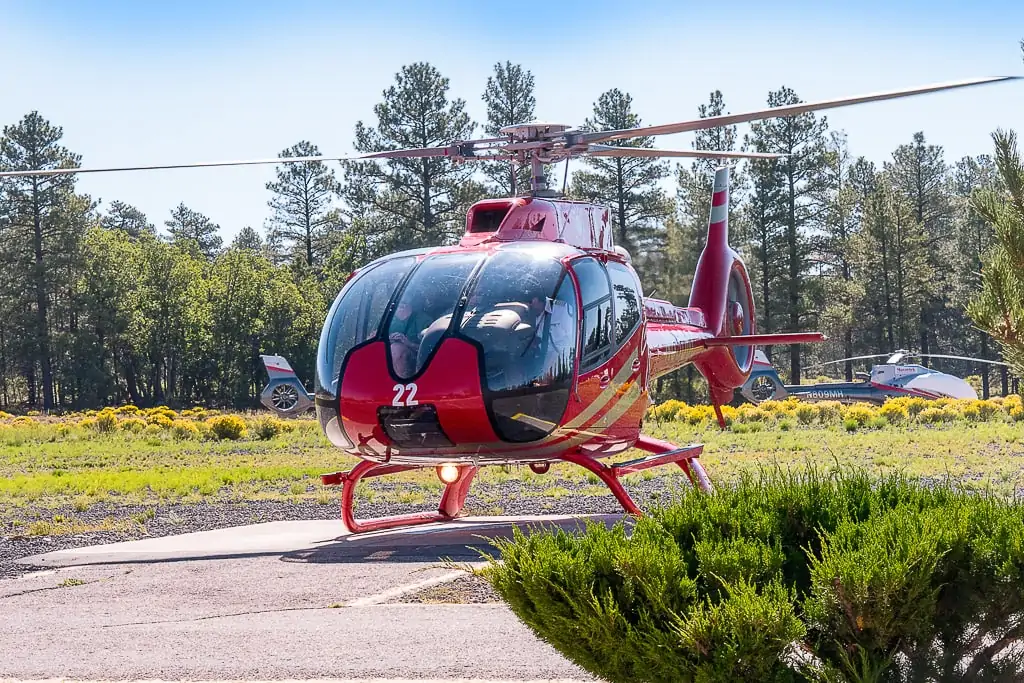
3 | Take the Scenic route along Desert View Drive and stop by the Tusayan Ruin
The Desert View Drive viewpoints are located between Grand Canyon Village and the East entrance of the park. There are some beautiful views of the Grand Canyon from the viewpoints along Desert View Drive.
Grand Canyon Itinerary tips: if you are driving to or from Page in Arizona then you will use the Grand Canyon East Entrance. This route means that you will drive the full length of the Desert View Drive en route to the Grand Canyon Village.
One of our favorite viewpoints is the Desert View Viewpoint which is the closest viewpoint to the East Entrance. For us, and many, this is the first-ever glimpse of the magnificent Grand Canyon and the panoramic views sweep from the plains of the Painted Desert to the east to the Colorado River disappearing far to the west. The viewpoint is also home to the Desert View Watchtower, a 5 story watchtower that was built in 1932 and is usually open for a climb to the top.
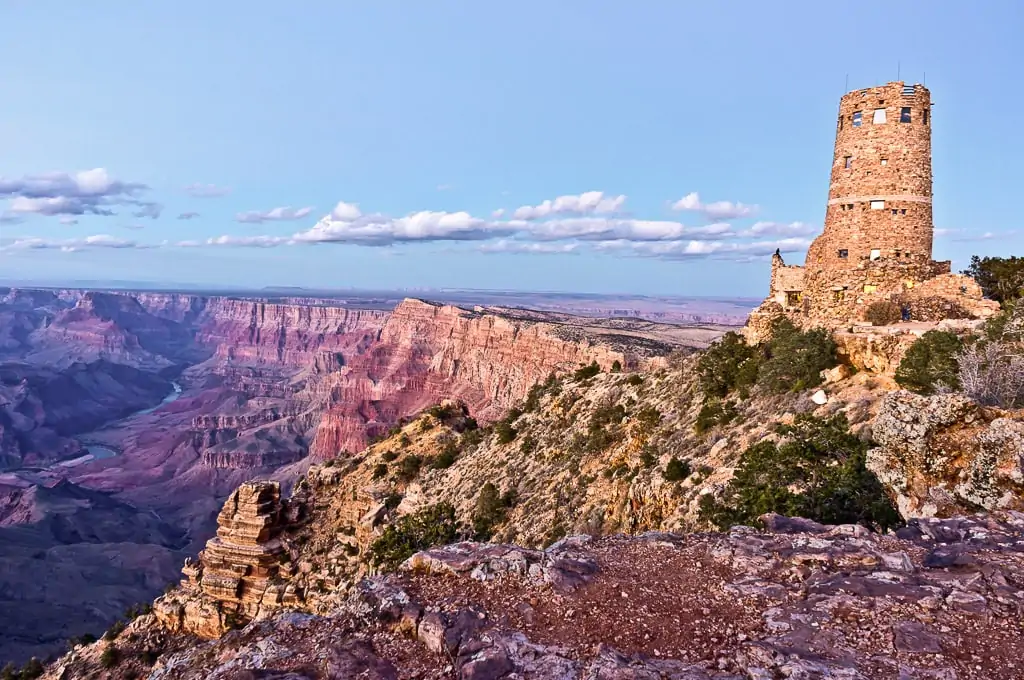
The Tusayan Museum and Ruin are 3 miles to the west of the Desert View Tower. You can walk around the remains of a small Ancestral Puebloan village and learn more through the interpretative signs. The museum has artifacts and traditional handicrafts made by ancestral Puebloans which date back as far as 4,000 years.
GrandView Point and Moran Point are other highlights. Horseshoe Mesa, a horseshoe-shaped red rock formation close to where the Last Chance copper Mine was established, is visible from GrandView Point. Moran Point sits atop Red Canyon and has a westerly view of the Grand Canyon.
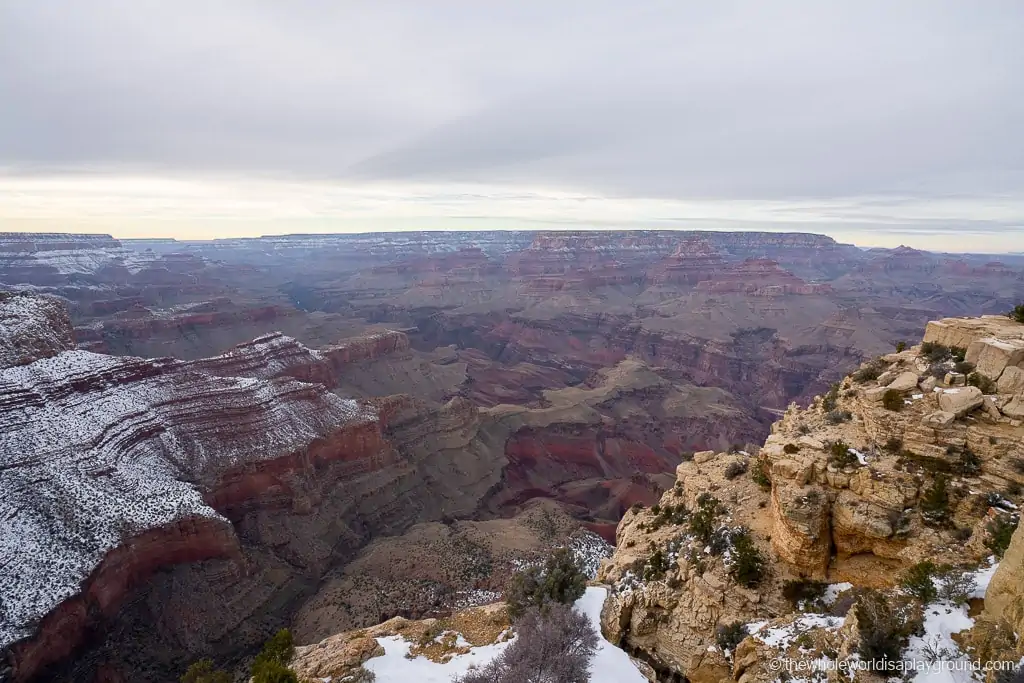
4 | Take a Mule Ride into the Canyon
For a truly unique experience at the Grand Canyon, visitors can take a mule ride down into the Canyon. Mules have been used at the Grand Canyon since the late 1800’s and are still used today to ferry visitors and supplies in and out of the canyon. Mules rides should be booked in advance and can be arranged by contacting the Grand Canyon Lodges here.
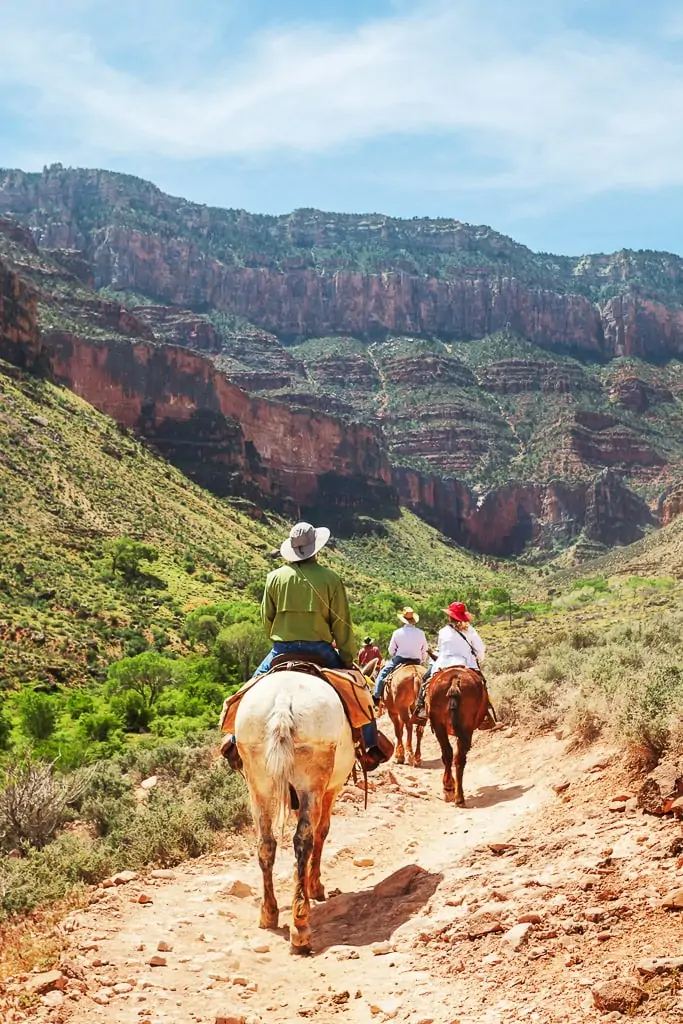
Grand Canyon 3 day itinerary
If you have the luxury of a third day at the Grand Canyon you can explore the canyon even further with the many long hikes on offer.
1 | Descend into the canyon on a mule and spend the night at Phantom Ranch
If you want to descend into the canyon but prefer something a little less strenuous than a rim to river hike, there are overnight mule rides to the base of the canyon. They include an overnight stay at the historic Phantom Ranch, the only accommodation at the base of the Grand Canyon. Mule rides should be booked in advance and can be arranged by contacting the Grand Canyon Lodges here.
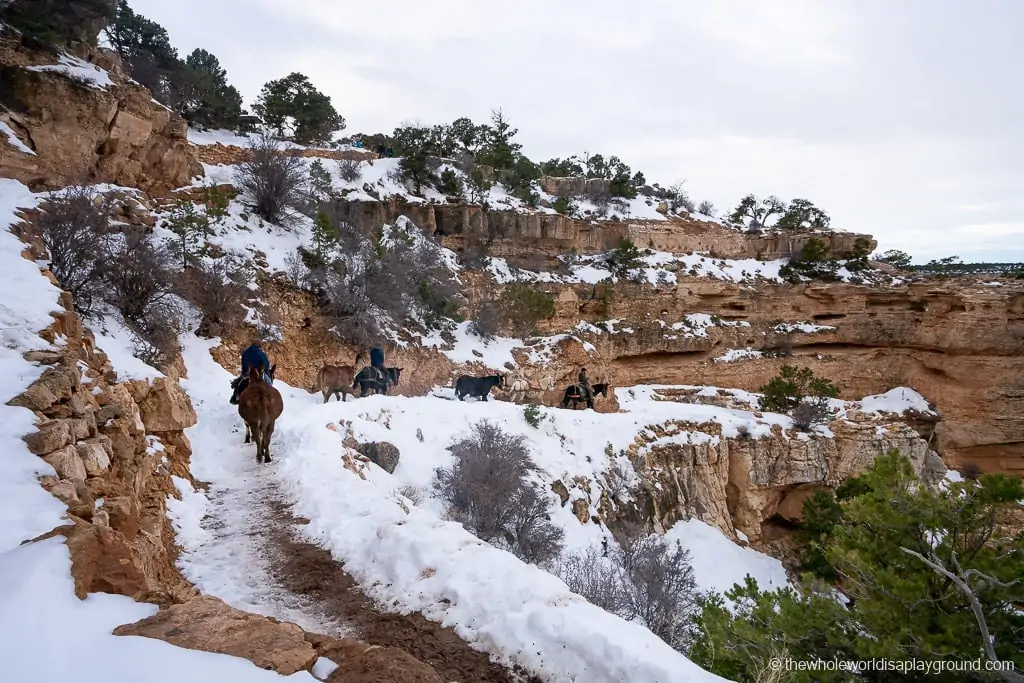
2 | Challenging Day Hike into the Canyon
If you have an extra day in your Grand Canyon itinerary then you might want to take the opportunity to do a challenging day hike below the rim. There are some fantastic day hikes into the Canyon but, again, it’s imperative that your physical health and fitness levels are up to the challenge and you are well prepared with hiking essentials including water and sunscreen.
Grand Canyon itinerary tip: Hiking down into the Grand Canyon is a long, strenuous and difficult undertaking and should only be attempted once you have researched the trails and prepared adequately. Exhaustion, dehydration and excessive heat are major issues faced by hikers and there are signs warning of the dangers along the trails. There have been many fatalities on the trial where heat and physical exhaustion have contributed The elevation change from the south rim to the Colorado River is over 4,000 feet so anyone planning to hike should be extremely well prepared.
Some of the best day hikes include:
Bright Angel
a rim to river hike, the Bright Angel trailhead is located at the rim beside Bright Angel Lodge. The trail follows a fault into the canyon via a series of steep switchbacks and passes mile and half resthouse, three-mile resthouse, and, after descending 3,000 feet, the lush Indian Garden with cottonwood trees and a stream known as Garden Creek – this is a great turning point for a day hike and it takes about 7 hours out and back depending on your hiking abilities. The hike back out is extremely challenging and it is only recommended for strong hikers.
Grand Canyon Itinerary Tip: there are campgrounds at both Indian Garden and at the bottom of the canyon beside Bright Angel Beach. Hikers can spend two nights at each campground per hike (4 in winter) and a backcountry permit must be obtained.
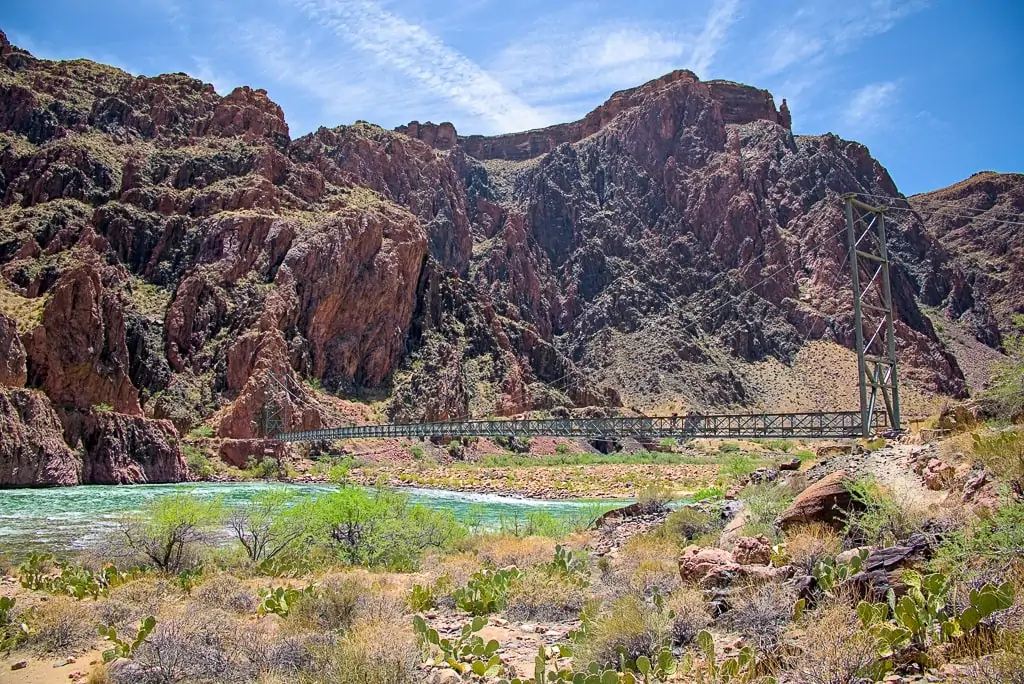
Grandview Trail
Grandview Trail was built in 1893 as a mining route to connect the rim with Horseshoe Mesa and, later, the copper mine. The loop is rocky and exposed and is 20.1km in total. Coconino Saddle is a popular viewpoint 1.1 mile along the trail and Horseshoe Mesa is 3 miles from the trailhead and a popular day hike. Artefacts from mining days gone past remain at top of the Horsehoe Mesa and there are also some camping spots.
Hermit Trail
This 1911 trail has an interesting history having been built to serve a luxury campsite close to Hermit Creek – there was even a tram to transport guests from the rim to the campground. Santa Maria Spring, a steep 2-mile descent, and Breezy Point, one mile further but similar elevation, are popular day hikes.
South Kaibab Trail
The South Kaibab Trail follows a ridgeline down into the Canyon and the views are spectacular but it’s a steeper hike up to the rim. There are lots of viewpoints along the South Kaibab Trail – after reaching one of our favorite viewpoints, Ooh Aah Point, Cedar Ridge is a good choice for a day hike and has amazing views of the Canyon.
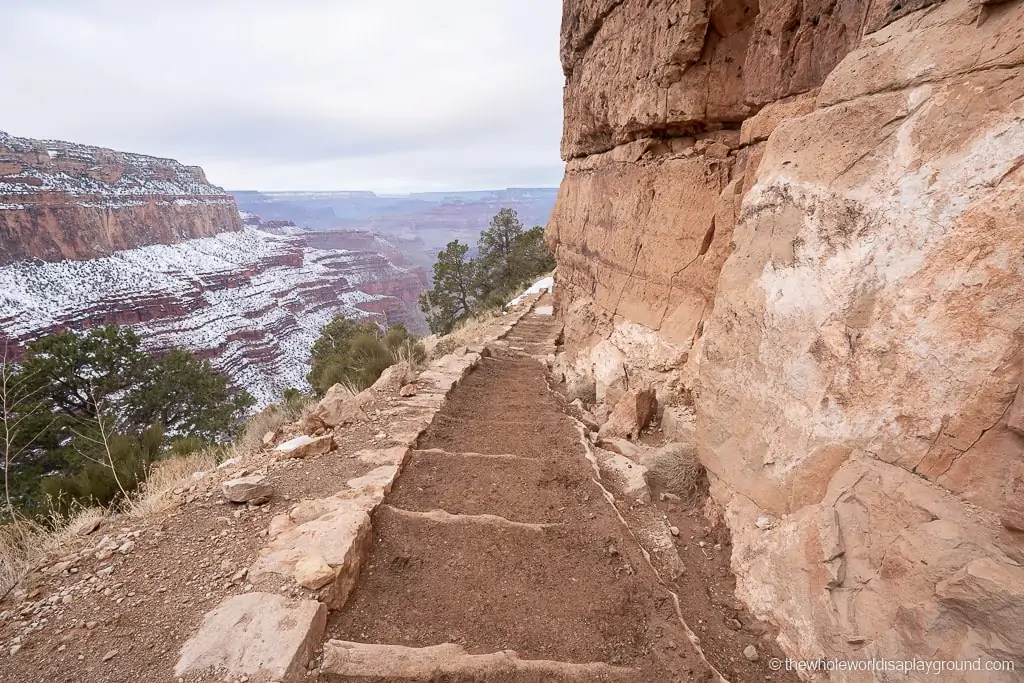
3 | Hike to the North Rim on the Rim to Rim Trail
If you want to dedicate all 3 days to an iconic hike then the Rim to Rim Trail is the obvious choice. The North and South Rim of the Grand Canyon are less than 10 miles apart but it takes 5 hours to drive the 220 miles between them. If you like a challenge, it is possible to hike Rim to Rim descending from the Bright Angel or South Kaibab trail on the South Rim and ascending to the North Rim via the North Kaibab trail. Visitors typically spend a night at Phantom Ranch or Bright Angel Campground at the bottom of the canyon. This is an extremely challenging hike and one which only a small number of visitors undertake.
Grand Canyon Itinerary Tip: if you want to travel between the North and South Rim, the Trans-Canyon shuttle transports passengers between the two. The journey time is around 4.5hours.
Grand Canyon National Park
The Grand Canyon is a truly unique and awe-inspiring sight. Located in Arizona, the Grand Canyon National Park covers almost 2,000 square miles and includes both the North and South Rim of the Grand Canyon (the West Rim, where the Skywalk is located, is on the Hualapai Native American Reservation and is not part of the Grand Canyon National Park). With visitor numbers reaching over 6 million in recent years, the Grand Canyon National Park is one of the most visited in the US.
The Grand Canyon National Park is a UNESCO World Heritage Site. Its deep red walls were carved over millions of years by the Colorado River and tell the story of 2 billion years of geological history.

Best time to visit Grand Canyon
The South Rim of the Grand Canyon is open 24 hours a day, 365 days a year. The moderate temperatures and lower crowds typically mean that Spring and Fall are considered the most desirable times to visit the Grand Canyon:
Spring
With moderate temperatures (averaging 50°F to 70°F), lower crowds and blooming wildflowers, Spring is one of the best times to visit the Grand Canyon. The weather can be a little unpredictable so pack plenty of layers and rain gear.
Summer
July and August are the busiest months at the Grand Canyon. Average temperatures at the South Rim reach the mid 80s°F and the long days are perfect for exploring – remember, temperatures increase by 5.5°F for each 1,000 feet of elevation loss so temperatures can easily reach over 100°F down at Phantom Ranch. Hiking can be challenging in the middle of the day so water and sunscreen are essential. Heavy rain showers are common in summer but they typically don’t last long.
Fall
Moderate temperatures (averaging 50°F to 75°F), fall foilage and lower crowds make Fall another great time to visit the Grand Canyon. Like spring, the weather can be a little unpredictable so pack plenty of layers and rain gear.
Winter
the Grand Canyon in Winter is often a place of solitude and beauty with less visitors resulting in quieter viewpoints and less expensive accommodation. However, the weather is generally very cold (lows of 20ºF to highs of 43ºF) with icy roads and trails and a high chance of snow. At the North Rim, all facilities and lodgings shut down for winter and roads are closed to all vehicles between December 1st and May 15th.
Grand Canyon itinerary tip: we’ve visited the Grand Canyon in Winter (as an extension of our Utah National Park Road Trip) and loved the low crowds and peacefulness of the park. However, it was cold and we had to navigate a snow storm on the day of our arrival!
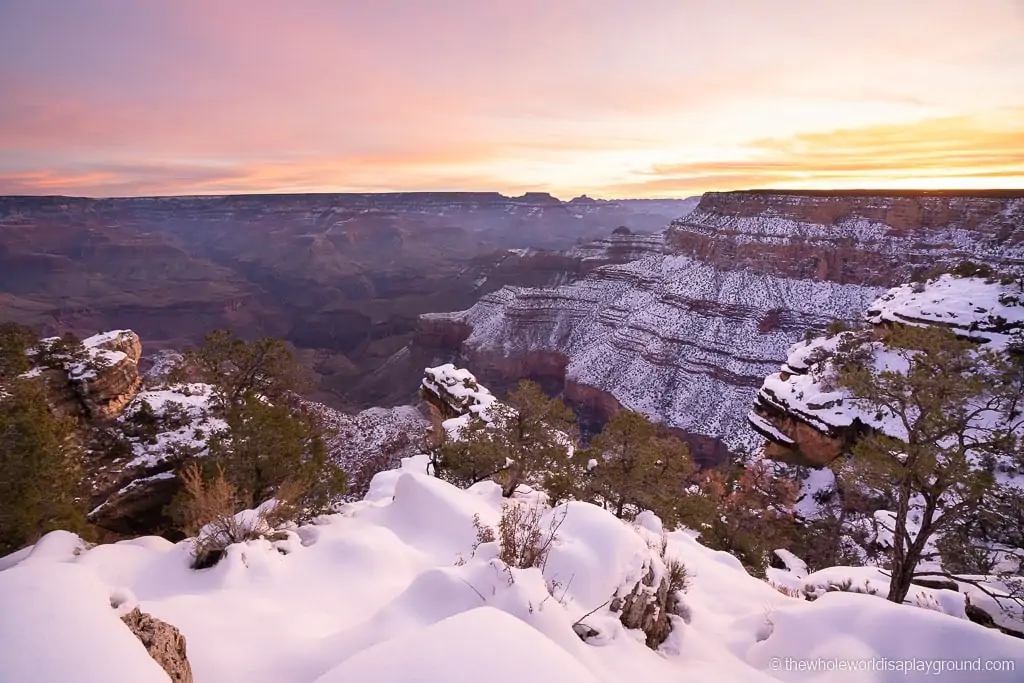
How long to spend at the Grand Canyon
It really depends on what you want to see and do! Some visitors stop by a couple of viewpoints and arrive and leave within a day but there are so many more fantastic things to do at the Grand Canyon. We recommend spending at least one full day at the Grand Canyon South Rim and ideally two if time permits.
One full day will allow time to explore some of the best viewpoints at the Grand Canyon, hike a portion of the Rim Trail, and maybe catch a sunrise and sunset. A second day will enable you to descend into the Canyon while exploring part of the Bright Angel or South Kaibab Trails and enjoy a scenic drive along Desert View Drive.
Check out our guide to exploring the Grand Canyon in one day for more ideas.
Grand Canyon Itinerary tip: on our last visit, we spent 2 nights at the Grand Canyon South Rim and had two full days to explore the park. It was the perfect amount of time to experience the Grand Canyon South Rim.
What to pack for the Grand Canyon
- Hiking shoes/boots and socks: make sure your hiking shoes or boots are worn in before hitting the Grand Canyon trails!
- Water Bottle/hydration pack: Elaine uses a Nalgene Tritan water bottle and Dave Takeya stainless steel bottle also have a Teton hydration pack for longer hikes.
- LED headlight: if you’re planning early morning or late evening walks then bring a headlamp. We used this Vont LED headlight when we set off for sunrise or sunset hikes.
- Yaktrax: if you are visiting in Winter Yaxtrax are amazing for navigating the icy trails – our favorites are these Yaktrax Walk Traction Cleats.
- Suncreen, sunhat, sunglasses: for summer visits
- Hiking jacket, light rain jacket, hat and layers: for winter visits
